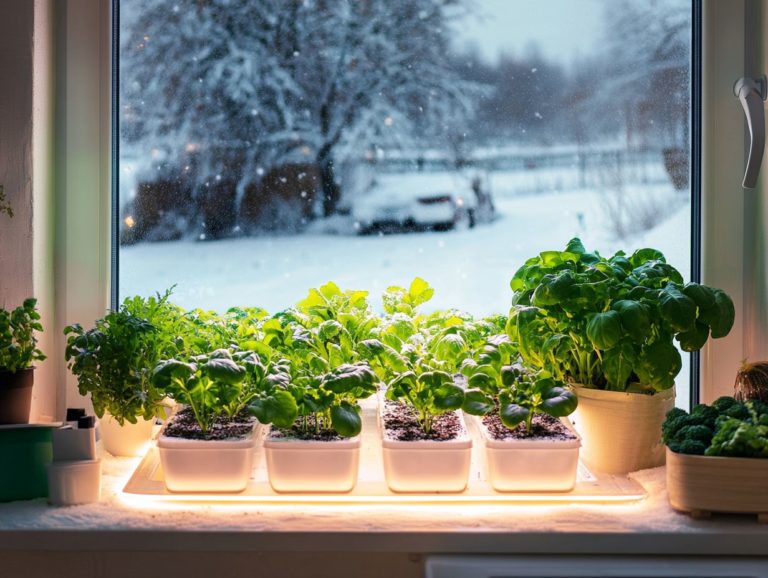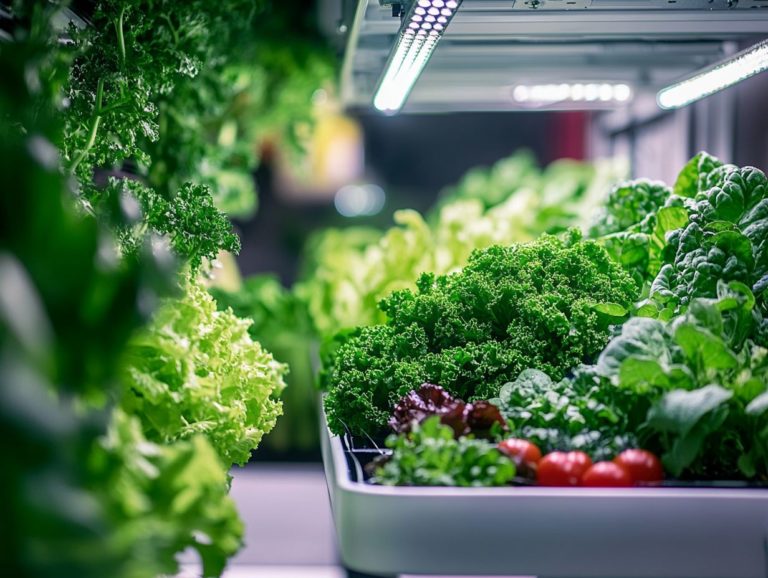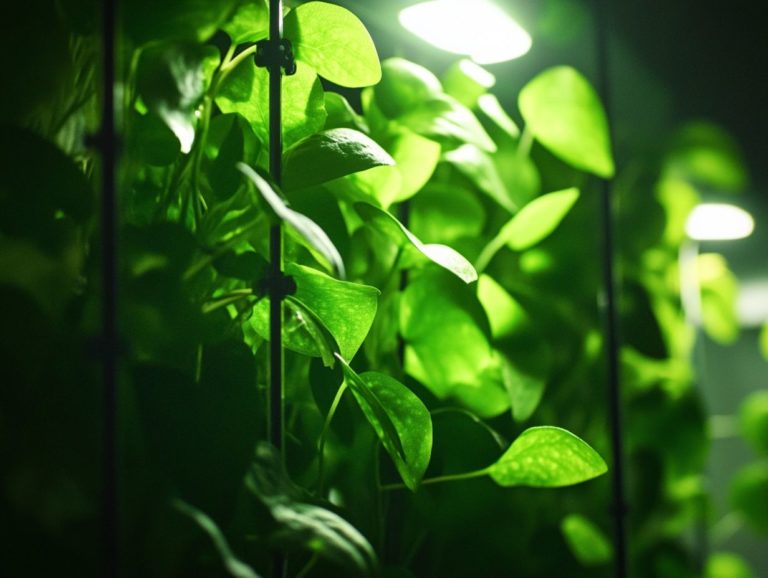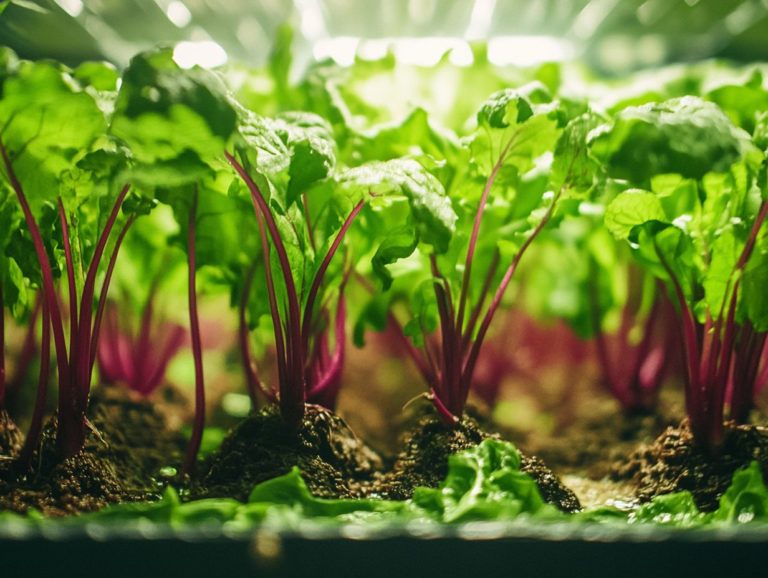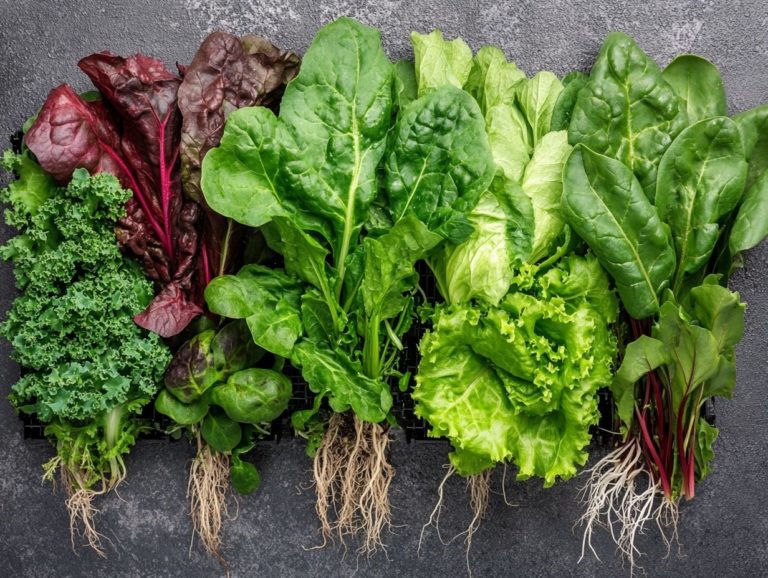“Best Varieties of Lettuce for Hydroponics”
When it comes to hydroponics, selecting the right varieties of lettuce can truly transform your hydroponic gardening experience! Get ready to explore the finest lettuce varieties that can maximize both yield and taste. Immerse yourself in this exploration to uncover which greens will flourish in your setup!
Contents
- Key Takeaways:
- 1. Romaine Lettuce
- 2. Butterhead Lettuce
- 3. Bibb Lettuce
- 4. Red Leaf Lettuce
- 5. Green Leaf Lettuce
- 6. Oakleaf Lettuce
- 7. Iceberg Lettuce
- 8. Arugula Lettuce
- 9. Spinach Lettuce
- 10. Endive Lettuce
- 11. Radicchio Lettuce
- 12. Frisee Lettuce
- 13. Kale Lettuce
- 14. Swiss Chard Lettuce
- 15. Mustard Greens Lettuce
- Frequently Asked Questions
Key Takeaways:
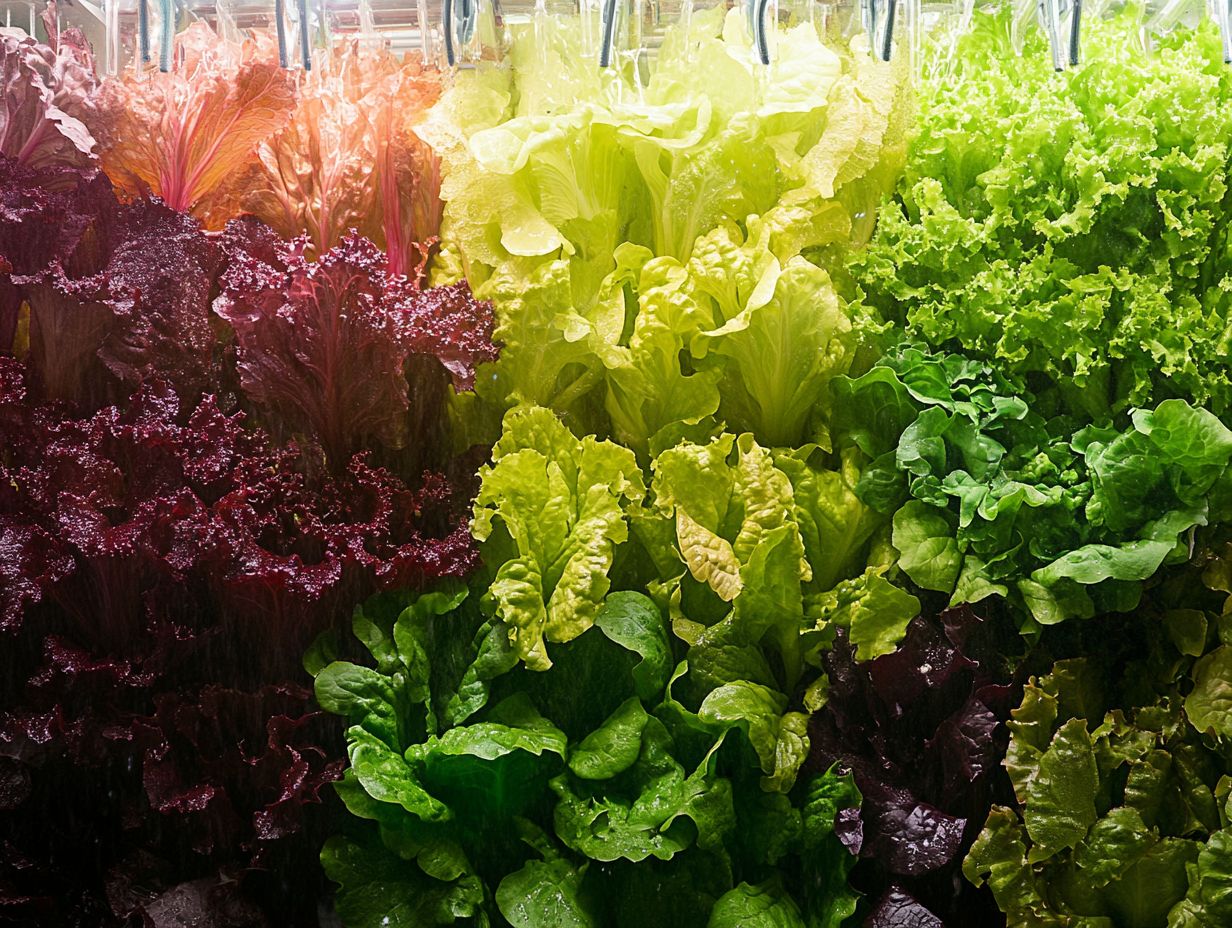
- Romaine lettuce is a popular choice for hydroponic systems due to its high nutritional content and resistance to diseases like E. coli.
- Butterhead lettuce is a versatile variety that can be grown in both warm and cool climates, making it a great option for hydroponic growers and container farming enthusiasts.
- Bibb lettuce is a tender and flavorful variety that is well-suited for hydroponic systems, as it can be harvested multiple times throughout its growing cycle and thrives under ideal temperature and light requirements.
1. Romaine Lettuce
Romaine lettuce, celebrated for its crisp texture and rich flavor, grows well in hydroponic systems. This method not only optimizes nutritional content but also minimizes the risk of environmental contaminants like E. coli.
With the potential for rapid growth, hydroponic Romaine thrives in controlled conditions. This makes it an ideal choice whether you re a passionate home gardener or part of a commercial greenhouse operation.
To achieve a bountiful harvest, Romaine lettuce thrives in temperatures of 60 to 70 degrees Fahrenheit. Extreme heat can cause bitterness and bolting, which you want to avoid.
In soil-less environments, aim to maintain a pH level between 5.5 and 6.5 to facilitate optimal nutrient absorption. Light is essential, so provide around 12 to 16 hours of bright, indirect light each day to encourage robust leaf development.
Nutritionally, this leafy green is a powerhouse, packed with vitamins A, C, and K, making it an excellent addition to your diet.
As a grower, it’s wise to remain vigilant against common pests like aphids and diseases such as downy mildew. Employ organic pesticides and practice crop rotation to protect your yields.
By implementing efficient maintenance practices like regular nutrient cycling and monitoring water quality you ll enhance the growth of hydroponic Romaine, ensuring a flourishing and abundant harvest.
2. Butterhead Lettuce
Butterhead lettuce, known for its tender leaves and delightful sweetness, is a prime choice for hydroponics. It adds a nice touch to your salads and culinary creations while being remarkably easy to cultivate under optimal nutrient conditions.
This leafy green comes in various enticing varieties, such as Boston and Bibb, each contributing its own unique texture and richness to your plate. With its buttery-soft leaves loosely encircling a central heart, Butterhead lettuce is visually appealing and a versatile ingredient in your kitchen.
Chefs love to use it to elevate sandwiches, wrap savory fillings, and craft vibrant salads that burst with flavor. Hydroponic techniques enhance the natural sweetness and crispness of this lettuce, resulting in a harvest that flourishes in a controlled environment.
Start your hydroponic journey today and enjoy fresh salads right from your garden!
3. Bibb Lettuce
Bibb lettuce is known for its tender leaves and subtle flavor. It can be expertly cultivated in hydroponic systems, ensuring it receives all the essential nutrients for a bountiful harvest.
Hydroponic setups let you control the growing environment. This variety loves temperatures between 60 F and 70 F. With the right light exposure of 12 to 16 hours a day and a well-balanced mix of nutrients, your lettuce will thrive, developing a lush texture and vibrant color.
Beyond its delightful taste, Bibb lettuce offers a rich nutritional profile. It delivers essential vitamins A and K along with beneficial dietary fiber. The hydroponic approach speeds up growth and reduces the risk of pests and diseases, enhancing both the quality and quantity of your harvest.
4. Red Leaf Lettuce
Red leaf lettuce stands out with its striking color and impressive nutritional profile. It adds visual appeal and a healthy touch to your meals. Plus, it s easy to grow in various systems.
Loaded with essential vitamins like A and K, this leafy green is a powerhouse for your dietary health. Its crisp texture and subtly sweet flavor make it perfect for salads, sandwiches, and wraps.
Love sustainability? Hydroponics boosts growth rates and nutrient density without soil! By meticulously controlling light, water, and nutrients, hydroponics elevates the quality and taste of this nutritious lettuce, making it an intelligent choice for your kitchen.
5. Green Leaf Lettuce
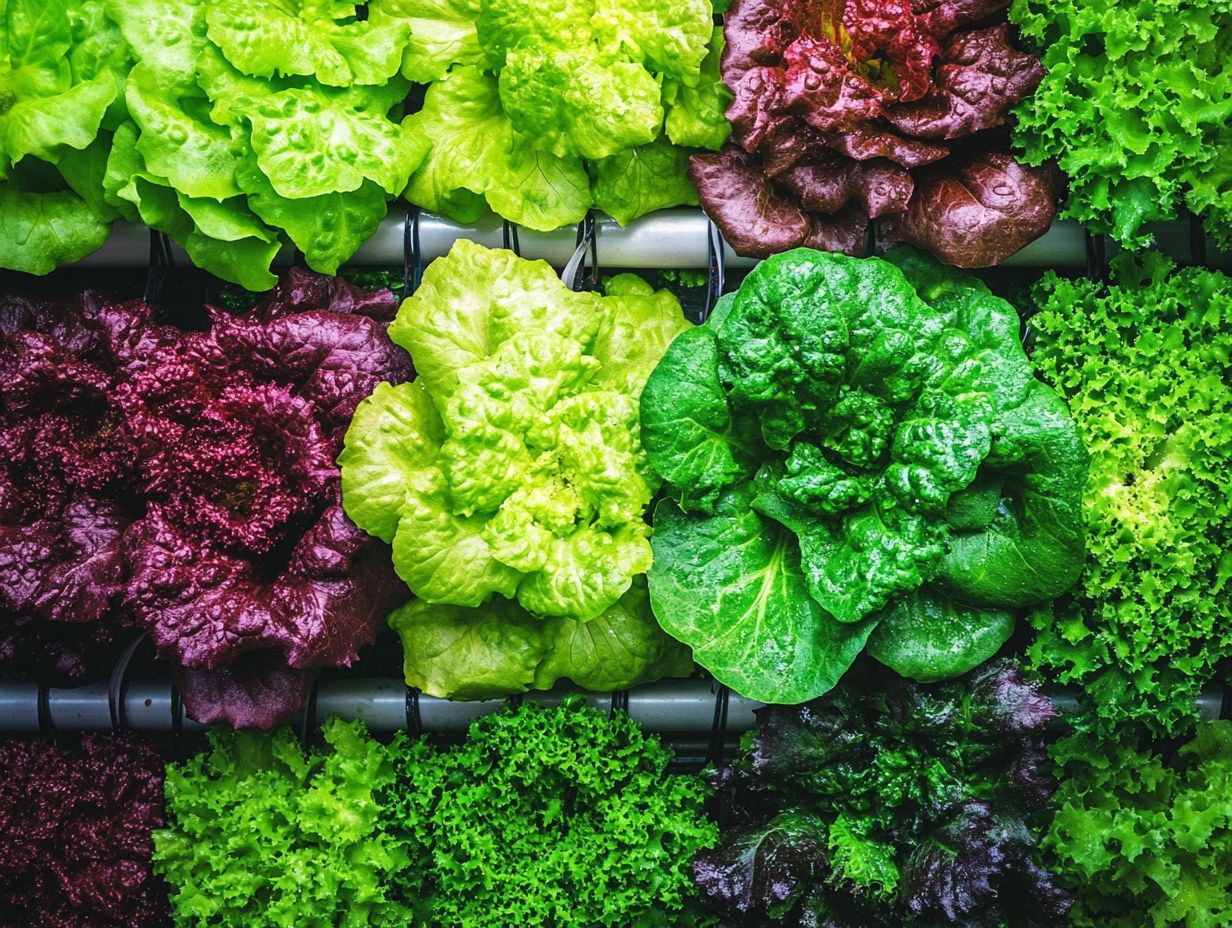
Green leaf lettuce is known for its delightful crispness and nutrient-rich profile. It flourishes in hydroponic systems, enabling swift growth and optimal production of essential vitamins and minerals.
This approach conserves water and reduces reliance on pesticides. This results in a cleaner and safer product for you. By adding this vibrant leafy green to your diet, you enhance your overall health with its abundance of antioxidants, vitamin A, and dietary fiber, supporting vision, digestion, and a robust immune system.
Want to grow this lovely lettuce? Start with the right pH levels and watch it flourish! Ensure sufficient lighting and regularly monitor nutrient solutions for a fruitful harvest.
6. Oakleaf Lettuce
Oakleaf lettuce, with its distinctive leaf shape and mild flavor, is an exceptional choice for hydroponic systems. By providing a balanced nutrient solution rich in nitrogen, potassium, and phosphorus, you can foster healthy growth.
This plant thrives in slightly acidic to neutral pH environments. It appreciates consistent moisture to ward off bolting. Keep an eye on nutrient levels, especially nitrogen and potassium, for strong leaf development and optimal taste.
Beyond its agricultural advantages, Oakleaf lettuce deserves a spot on your plate. It’s packed with essential vitamins A and K, vital for supporting vision and bone health. Its delightful crunch and moisture retention make it a superb addition to salads, adding a refreshing touch to your meals.
7. Iceberg Lettuce
Iceberg lettuce, with its signature crisp texture and mild flavor, can be expertly cultivated in hydroponic systems. Hydroponics is a method of growing plants without soil, using nutrient-rich water instead. This approach not only accelerates growth but also allows for swift harvesting and efficient storage techniques, all while ensuring the lettuce remains fresh.
By employing this method, you maximize yield and guarantee that each head retains its delightful crunch. For the best results, keep a close eye on nutrient levels, carefully adjust the pH, and provide sufficient light to foster healthy leaf development.
Once you’ve harvested your hydroponically grown lettuce, store it in a cool environment, ideally between 32 to 36 degrees Fahrenheit. Wrapping it in damp paper towels or placing it in breathable containers will help retain moisture without sacrificing that all-important crispness and freshness of the lettuce. These storage techniques are vital for maintaining the exquisite crunchiness and vibrant flavor that icebergs are renowned for.
8. Arugula Lettuce
Arugula, celebrated for its peppery flavor and impressive nutritional profile, flourishes in hydroponic gardens, making it the perfect choice for you as a salad enthusiast eager to elevate your culinary creations with its distinct taste.
This leafy green isn’t just a delightful addition to salads; it has the power to enhance pastas, sandwiches, and pizzas, delivering a burst of flavor that beautifully complements a wide variety of ingredients. Beyond its culinary appeal, arugula is rich in vitamins A, C, and K, along with essential minerals like calcium and potassium, making it a fantastic ally in maintaining a balanced diet.
To ensure you achieve the best flavor and nutrient density, optimal hydroponic conditions are key: a solution full of nutrients, generous lighting ideally 12 to 16 hours a day and a temperature range of 60 to 65 F. With the right approach, you can cultivate this peppery green and enjoy a plentiful harvest of fresh, flavorful leaves from your hydroponic garden.
9. Spinach Lettuce
Spinach, the nutrient powerhouse that s taken the health world by storm, is easy to grow in hydroponic systems. This method allows for swift growth and provides you with essential vitamins in a sustainably chic way.
Loaded with vitamins A, C, and K, along with vital minerals like iron and calcium, spinach supports your overall health, making it a fantastic addition to your diet if you re looking to elevate your nutrition. Its versatility means you can easily toss it into salads, blend it into smoothies, or fold it into omelets and pasta dishes.
The hydroponic environment provides plentiful light and nutrient-rich water, creating the perfect conditions for spinach to flourish. Don t miss out on enjoying fresh greens year-round. This means you, as a health-conscious eater, can reap all the dietary benefits without the limitations of conventional farming.
10. Endive Lettuce
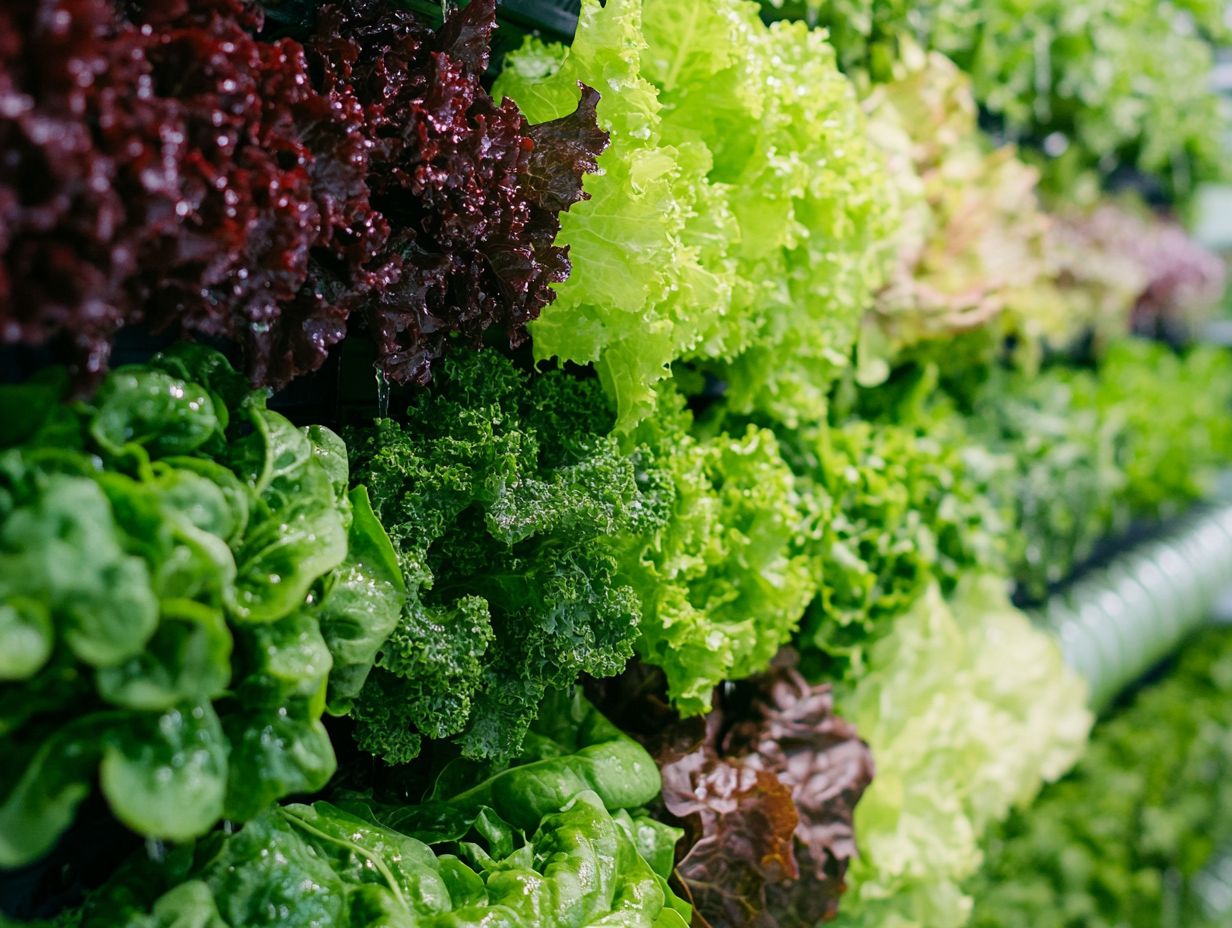
Endive, with its slightly bitter flavor and crisp texture, is a versatile leafy green that thrives beautifully in hydroponic conditions. It provides a unique touch to your salads while enhancing your overall health. Endive is a great choice among the many types of lettuce available for hydroponics.
Growing endive using hydroponic techniques not only accelerates its growth but ensures it reaches its full, nutrient-rich potential. These soilless methods grant you precise control over nutrient levels and water supply, resulting in vibrant leaves that maintain their delightful crunch.
In the kitchen, endive can be braised, grilled, or stuffed, making it a wonderful addition to a variety of dishes, from gourmet salads to warm side plates. This leafy green is loaded with vitamins A and K, fiber, and antioxidants, all contributing to better digestion and heart health truly a wise choice for anyone mindful of their wellness.
11. Radicchio Lettuce
Radicchio, with its captivating color and delightful bitter-sweet flavor, is a prime choice for hydroponic gardening. Not only does it impart unique flavors that elevate your culinary creations, but it is also brimming with nutrients, making it an ideal addition for those interested in a nutritional diet.
To ensure optimal growth, this vibrant leafy vegetable flourishes in well-controlled environments. It needs approximately 12 to 16 hours of bright, indirect light each day. Maintain a pH level between 6.0 and 7.0 in your hydroponic system, supplemented with nutrient solutions rich in nitrogen, potassium, and calcium to encourage robust leaf development.
Thanks to its versatility, radicchio shines in a variety of dishes be it in salads, grilled as a tantalizing side, or even tossed into pasta recipes. It adds a distinct, peppery kick that will surely please your palate. Imagine fresh, home-grown Radicchio in your next salad!
12. Frisee Lettuce
Frisee, with its curly leaves and distinctive texture, is a remarkable addition to hydroponic gardens. It elevates your salads while delivering a host of health benefits. Growing frisee requires the right mix of nutrients to thrive.
This leafy green is packed with vitamins A and K, along with antioxidants that support your overall health and wellness. In the kitchen, frisee adds a delightful crunch and artfully balances flavors, making it a top choice for gourmet dishes.
To achieve optimal growth in your hydroponic system, maintain a consistent temperature between 60 F and 70 F and provide adequate light exposure for about 12-16 hours each day. These conditions will encourage vigorous growth and enhance the vibrant flavor profile of this versatile lettuce.
13. Kale Lettuce
Kale, a true powerhouse of nutrients and a favorite among health enthusiasts, thrives beautifully in hydroponic systems. This method facilitates rapid growth and grants easy access to its myriad health benefits.
With an impressive supply of vitamins A, C, and K, this leafy green is a champion in the realm of nutrition. It packs a noteworthy punch of calcium and antioxidants, essential for boosting overall health.
Kale is a versatile ingredient perfect for salads, smoothies, or even baked chips. If you’re eager to dive into hydroponic cultivation, focus on optimal nutrient levels, maintain the right pH balance (a measure of how acidic or alkaline a solution is), and ensure ample light exposure.
By embracing these best practices, you can enjoy a bountiful harvest right from the comfort of your home. Get ready to indulge in delicious dishes!
14. Swiss Chard Lettuce
Swiss chard, with its vibrant stems and broad leaves, flourishes in hydroponic systems. This leafy green adds nutrition and visual appeal to your dishes. Its versatility makes it ideal for various culinary applications.
Swiss chard is a powerhouse of vitamins A, K, and C, along with essential minerals like magnesium and potassium. Whether you choose to saut , steam, or toss it into salads, its earthy flavor pairs well with a wide range of ingredients, elevating your meals with both color and nutrition.
To optimize growth in your hydroponic setup, Swiss chard prefers cooler temperatures, consistent moisture, and nutrient-rich solutions. With the right care, you can enjoy a continuous harvest, making Swiss chard a go-to staple for any health-conscious chef. Don’t miss out on incorporating this green into your meals!
15. Mustard Greens Lettuce
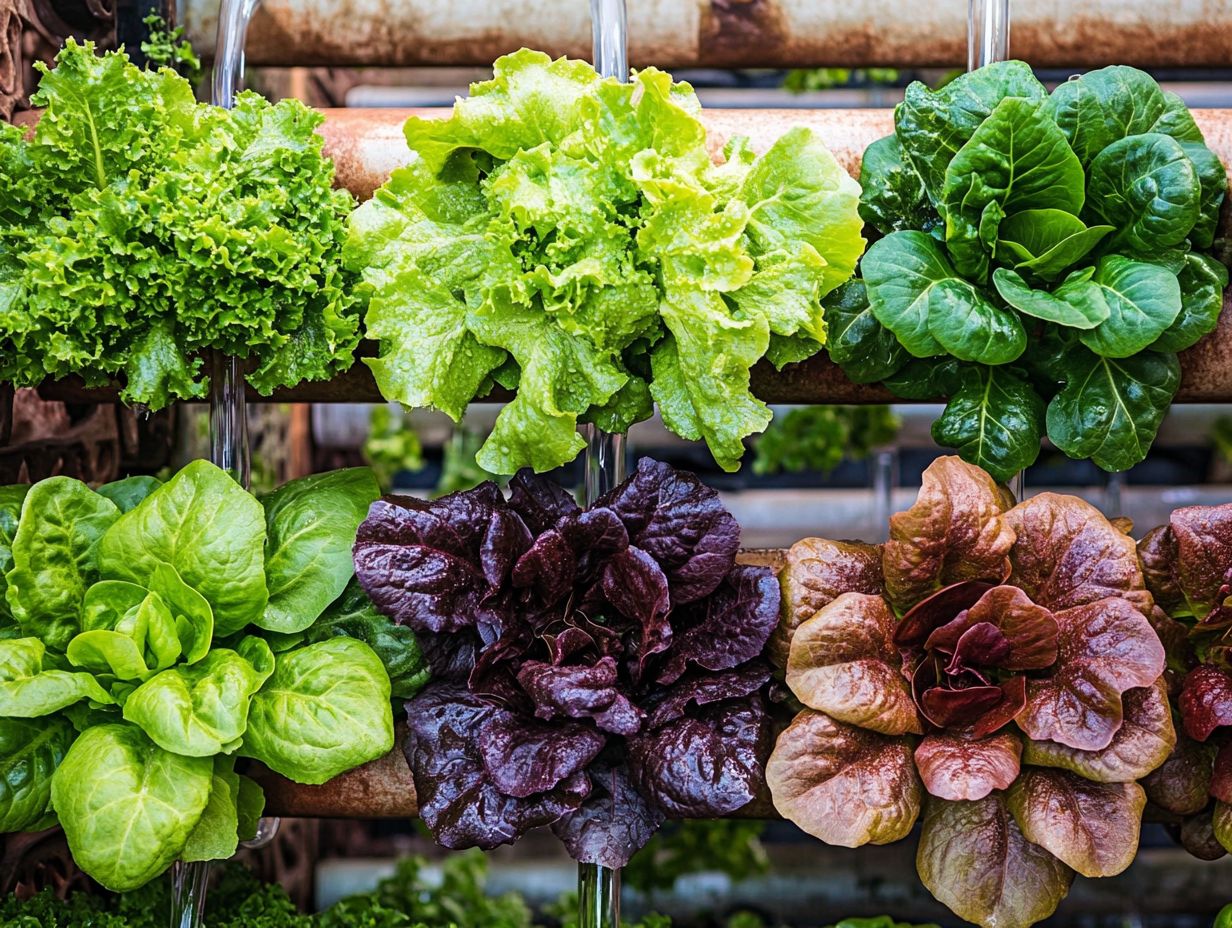
Mustard greens, known for their peppery bite, thrive beautifully in hydroponic systems. These greens add a zesty flavor to your meals while delivering an array of health benefits, making them versatile for a variety of dishes.
These greens belong to the Brassica family and are nutrient-rich. They boast an impressive array of vitamins A, C, and K, along with a commendable supply of essential minerals like calcium and iron. Their unique flavor elevates a range of dishes, from crisp salads to savory stir-fries, making them a go-to choice for discerning home cooks.
To successfully grow mustard greens in a hydroponic setup, it’s crucial to maintain optimal conditions. By maintaining these conditions, you promote robust growth and enhance the vibrant flavors that make mustard greens a delightful addition to your culinary repertoire.
Frequently Asked Questions
How can I ensure my lettuce seeds germinate successfully in hydroponic systems?
What are the best varieties of lettuce for hydroponics?
Some of the top choices include butterhead lettuce, romaine lettuce, and oak leaf lettuce.
The best varieties of lettuce for hydroponics include Bibb, butterhead lettuce, romaine lettuce, and oak leaf lettuce.
Why are these varieties considered the best for hydroponics?
These varieties are easy to grow in hydroponic setups. Their shallow root systems and ability to tolerate high moisture levels make them ideal.
These varieties are perfect for hydroponics because they have shallow root systems, can handle high moisture, and have a quick growth cycle, making them favorable for container farming.
What is Bibb lettuce?
Bibb lettuce, also known as Boston or Butter lettuce, is a variety with small, loose heads and tender leaves. It is a popular choice for hydroponic growing due to its delicate texture and mild flavor, commonly found in salads.
What is Romaine lettuce?
Romaine lettuce, also known as Cos lettuce, features long, sturdy leaves and a crisp texture. Its strong roots make it ideal for hydroponic systems with deep water culture or nutrient film techniques, showcasing its nutritional benefits.
Start your hydroponic journey today and enjoy fresh greens at home!
Can I grow other types of lettuce in a hydroponic system?
Yes! You can grow varieties like Iceberg, Oakleaf, and Red leaf lettuce in your hydroponic setup. Just keep in mind, they need more space and have longer growth times than other types.
What should I consider when growing lettuce in a hydroponic system?
It’s crucial to keep a steady temperature of around 70 F. Also, monitor the acidity, known as pH, which should be between 5.5 and 6.5.
Regularly check and adjust nutrient levels for a successful harvest!

